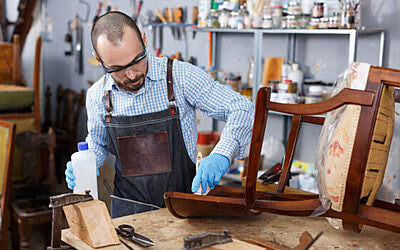Repairing and restoring damaged wood furniture involves several steps. Here's a simplified guide for the process:
1. Inspection: Begin by thoroughly examining the piece of furniture. Look for any noticeable scratches, gouging, peeling or missing pieces. Make a note of all the spots that look damaged or worn out.
2. Cleaning: Start by dusting off the surface using a dry cloth. After dusting, clean the piece with a mild soap and warm water. Rinse with another damp cloth, and dry it using a towel to prevent water absorption.
3. Stripping: If the item is varnished or painted, you may have to strip it off using a chemical stripper. Apply the stripper with a paintbrush, wait for it to work its magic and then scrape it off with a plastic scraper. Always wear proper protective gear when working with chemicals.
4. Sanding: Once the piece is dried completely after stripping, use a sandpaper to smooth out the uneven surfaces, scratches or patches. Start with a coarse-grit paper (like 60 or 80-grit) and work your way up to finer grits (like 220-grit) for a smoother finish.
5. Repairing: Repair the broken or missing parts of the furniture. Glue can be used to stick the broken parts together, whereas for missing parts wood putty or filler can be used. Once it's dried, sand it down to level with the rest of the surface.
6. Staining: Once the furniture is repaired and sanded, apply a wood stain using a brush or cloth to give it a fresh look. Always apply the stain in the direction of the grain, and wipe away any surplus stain with a clean cloth.
7. Sealing: After the stain is dried, seal the furniture by applying a clear finish, such as polyurethane, varnish, or lacquer. Use a clean brush to apply, and always do so in the direction of the grain.
8. Polishing: Once the sealing is dried, use a soft cloth to apply a coat of furniture wax. This will enhance your furniture’s sheen and add an extra level of protection.
Remember, safety first – always use protective gear like gloves and goggles, and work in a well-ventilated area. Each product (like stripper, stain, sealers, etc.) come with their own set of instructions – always follow them for the best results. In case the damage is severe or the piece is an antique, you might want to consult a professional.

